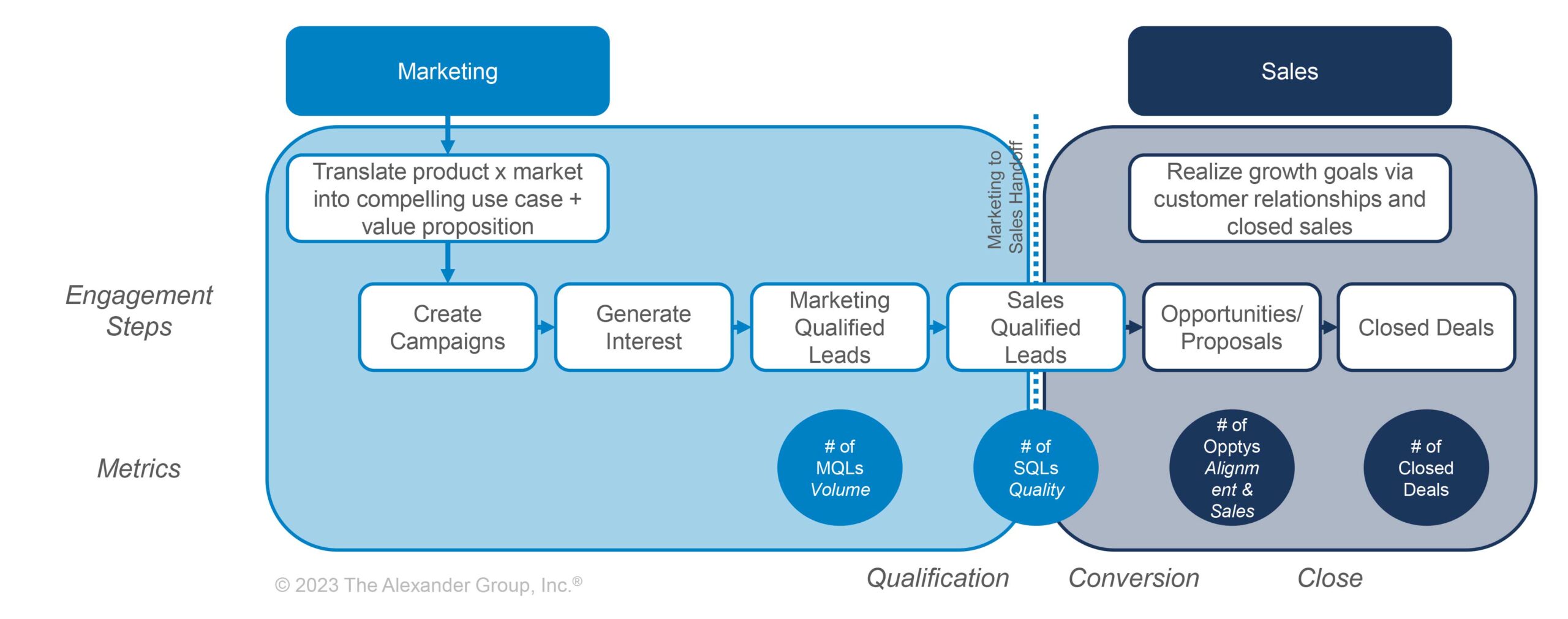Step 1: Volume of Marketing Qualified Leads Reflects the Success of the Marketing Team’s Messaging and Market Fit
At the top of the funnel, the first success metric to track and test is marketing qualified leads (MQLs). MQLs refer to individuals Marketing has identified that have a need for our offering, are interested in our offering and can purchase our offering. MQLs are an indication of the breadth and accuracy with which the Marketing function was able to reach prospective customers. A high volume of MQLs is good, as the more MQLs generated, the higher the number of leads that Sales can start with. Given that there are multiple qualification stages between MQLs and a closed deal, the higher the number of MQLs, the better chance the organization has of meeting its targeted number of closed deals at the end of the sales process. A low volume of MQLs indicates room for improvement in the Marketing function either in identifying the target market, the campaigns used to introduce the market to our offerings or the quality of the campaigns in generating interest in our offerings.
To improve the volume of MQLs, Marketing should review the campaigns run and the MQLs generated from each specific campaign to better understand whether certain campaigns perform better than others. If the campaigns produce similar results and yield an overall lower-than-expected volume of MQLs, Marketing should reevaluate the target market.
Step 2: MQL to SQL Qualification Rate Indicates Quality of Marketing Sourced Leads
The “hand-off” point between Marketing and Sales comes when MQLs are reviewed by Sales and approved as sales qualified leads (SQLs). SQLs meet more rigorous criteria than MQLs and indicate a higher likelihood of the lead converting to a customer. These criteria often include verification that the identified buyer has the authority, budget and intent to purchase our offering. The qualification rate of MQLs to SQLs is a key indicator of the alignment between Marketing and Sales and refers directly to the quality of the MQLs sourced by the marketing team. If the marketing teams’s target population criteria and approach align to the sales strategy, we should see a higher qualification rate of MQLs to SQLs. If Marketing is sourcing leads that are not aligned to the sales strategy and our organization’s capabilities, we would expect this step to filter out many of the MQLs handed over to Sales, resulting in a low qualification rate. As a specific example, the alignment of key buyer personas between Marketing and Sales is a critical strategic decision point that could impact this qualification rate.
To correct a low SQL qualification rate, Sales and Marketing should collectively review their target markets and key buyer personas to ensure alignment, and course correct as necessary.
Step 3: Conversion Rate of SQLs to Opportunities/Proposals
How do you take a prospect that is a SQL and turn it into a viable opportunity or proposal? A SQL becomes an opportunity when the prospect has expressed active interest or intent to make a purchase and to progress in the sales process. Opportunities are buyers who agree to meet with the sales team and discuss a proposal specific to their organization’s needs. The conversion rate of SQLs to opportunities/proposals speaks to the successful alignment between Marketing and Sales. If the conversion rate from SQLs to opportunities/proposals is low, there are three key root causes to evaluate:
- Marketing and sales strategies are misaligned – the prospects Marketing is bringing into the overall funnel are not as good of a match for our offering and true value proposition as initially expected.
- Prospects are not yet ready to buy (or to move to the next step in the sales process). In other words, we are attempting to convert too quickly and the buyer’s need is not imminent.
- Our sales team is not adequately equipped with the tools or knowledge necessary, does not have the talent to successfully convert, or is not structured in a way that resonates with the prospect’s buying process.
To improve conversion rates from SQLs to opportunities/proposals, it’s important to identify the root cause of those SQLs that do not convert. The first step should be reviewing feedback from prospects and from the sales team to identify trends in non-converted SQLs. From there we can pinpoint whether the issue stems from (1) a lack of connection with the prospects we are working with (e.g., incorrect target market or non-compelling value proposition), (2) a timing issue – the right prospects, but not yet ready to purchase, or (3) an ill-equipped sales team. If the issue is a lack of connection with our prospects, we must strategically reevaluate our targeting and value proposition across Marketing and Sales. If our sales conversations are premature, we need to identify additional guardrails to ensure the leads being shared with Sales have an imminent need and available budget to purchase from us.
If the root cause of our low conversion does not stem from one of these issues, it’s likely driven by the Sales function itself. There is a spectrum of causes that may be driving the Sales function to be unsuccessful in converting SQLs to opportunities/proposals. For example, these can stem from the structure of the sales team, the enablement of the sales team or the inherent talent on the sales team. There may be specific feedback from the sales team and/or prospects that can help home in on the root cause of the issue. If not, a more comprehensive assessment of the go-to-market model may be necessary to determine the specific opportunities for improvement. Based on the results of the assessment, remedies could span from redefining the individual jobs and scope of responsibility of our sales team, to developing additional training and investing in resources to better enable our sales team, to a gap assessment of incumbent talent to job expectations which could require hiring individuals better equipped to deliver on leadership’s expectations for the job.
Step 4: Number of Closed Deals
The final stage of the marketing and sales funnel is the closed deal, indicating an opportunity/proposal’s move to an engaged customer. The number of closed deals is the ultimate measure of success for the overall funnel and is the culmination of all efforts up to this point. A closed deal means that sales has negotiated the final proposal and price point with the prospective buyer and that the buyer has accepted and signed the terms of the agreement. Each closed deal marks one step closer to realizing the organization’s growth goals.
A low close rate of opportunities/proposals can speak to how well the seller knows the buyer, their needs, and their potential objections:
- Has the seller responded to all the buyer’s concerns?
- Has the seller adequately aligned the value proposition of the organization’s offering to the buyer’s needs?
Alternatively, a low close rate can be a symptom of a more acute issue. At this point, it is important to track the feedback on lost deals and review them on a regular cadence. It is possible that there is a specific breakpoint that must be addressed at a broader level of the organization. For example, this could be a pricing issue, an integration issue with the offering and customer platforms, a disconnect with a specific group of buyers or any number of issues that make a prospect walk away from the deal. Each of these specific breakpoints requires a unique solution to address, the more specifically you can diagnose the issue, the easier it will be to solve.
Why Does It Matter?
When Sales and Marketing work together effectively, they can generate more high-quality opportunities, improve velocity through the funnel and overall win rates and lead to more cost-efficient operating models. When leveraged appropriately, the Marketing function should generate interest in the company/offering, can better qualify leads and drive more potential customers to action. By driving a better overall customer experience, companies can create unique success stories that can be leveraged with prospects and further the brand.
An integrated marketing strategy can amplify the message of a sales organization. By having a broad reach, Marketing can identify additional opportunities that may otherwise have been missed by sales resources. This can lead to an increase in the total number of opportunities. More high-quality opportunities passed to the sales team generally equate to more revenue. Companies that align sales and marketing teams achieve 20% higher revenue 1. Further, by targeting the right audience at the right time, Marketing can improve communication at all stages of the buying process, which can lead to better engagement and stronger long-term relationships.
The interlock between the sales and marketing funnel is also crucial to maximize the capture rate of new logos. Marketing can identify areas of product/market fit, yielding a strong pool of opportunities earlier in the customer journey. With strategically aligned marketing campaigns, companies can reach a wide breadth of prospects with the right message. Sales can better qualify and close those opportunities. Companies that align sales and marketing teams achieve 40% better win rates 1. Coordination and co-ownership of the customer journey are essential factors impacting close rates. Lack of integration can result in marketing funnel friction, leading to a loss of potential customers.
Aligning Sales and Marketing can increase efficiency and cost savings. High-cost sales resources such as account executives can focus on the ‘land’ stage of the sales process, while lower-cost marketing resources can take on some or all the identification responsibility. Sales development representatives will be more efficient, as they are qualifying higher quality leads. Offloading these responsibilities can lead to cost savings and increased efficiency. Additionally, sales feedback loops can improve customer profiles, leading to better targeting and more effective marketing efforts. Companies that align sales and marketing teams achieve 25% faster profit growth compared to companies with poor alignment. 1
Siloed Sales and Marketing functions result in inefficiencies in the overall go-to-customer model and higher cost of sales. Notably, siloes can cause misalignment in the messaging and approach to acquiring new logos and opportunities and can diminish the number of leads generated at the top of the funnel. This decrease in effectiveness has downstream impacts on the customer acquisition process and, potentially, the entire sales model. With fewer and/or lower-quality initial leads to convert, sellers are handed a difficult hand in converting those leads. This can require additional time and effort from our high-cost sales resources to close deals. Similarly, the functional overlap of marketing and sales teams that are not in sync is costly to the company and reduces the effectiveness of both functions. Aside from cost, functional overlap can diminish the customer experience and lead to frustration and confusion among internal employees.
Find out how Alexander Group can help your organization align your sales and marketing teams to drive profitability.
1 Based on Alexander Group expert interviews.




